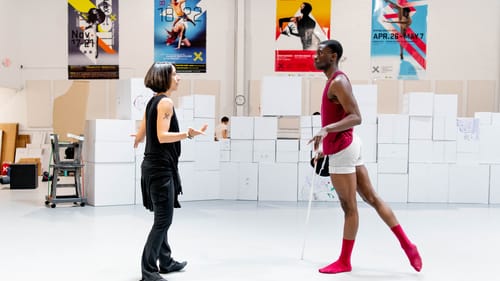Stay in the Loop
BSR publishes on a weekly schedule, with an email newsletter every Wednesday and Thursday morning. There’s no paywall, and subscribing is always free.
'The Little Prince' comes to life at the Wilma Theater

For children, classical ballet offers fairytale settings and sparkling tutus as a glittering introduction to the art. But contemporary ballet goes for big emotions, politics, taxes. Well, maybe not taxes, but even The Little Prince’s choreographer, Annabelle Lopez Ochoa, admits, “Sometimes contemporary dance can be a little scary for younger audiences.”
BalletX’s artistic and executive director Christine Cox wants to fix that with a modern narrative ballet that children can enjoy as much as their families—and Ochoa is just the choreographer for the job. Her relationship with the company goes back to the whimsical piece “Still@Life” for BalletX’s 2008 season. “Why do all these painters paint, like, an apple in a bowl?” she asks. “And seriously, not a banana or an artichoke, it’s always an apple, half rotten!” So she’s funny, but she also brings thoughtful sensitivity to her whimsy.
A Small Book with Big Themes
Ochoa chose Antoine de Saint-Exupéry’s classic The Little Prince for its deceptive simplicity. She explains, “They are very simple sentences but the message is so deep, and that’s why it fits children, because they are like, ‘Oh, a fox, look, a star,’ and then, ‘Oh a snake.’ But then the older audience will understand all the symbolism of it.”
In the book, a prince who lives on a tiny asteroid with only a temperamental rose for company, flies across the universe on a flock of birds. Each asteroid he visits has one resident of its own: an adult far too busy to answer a small boy’s questions. One, for example, has laid claim to the stars and is counting them in a ledger. When the Prince falls to earth he meets a snake, a fox, and a pilot lost in the desert.

“For me,” Ochoa explains, “reading the book again… and setting it, I actually see the layers much more.” The planets represent the deadly sins: greed, vanity, pride. Lurking beneath the child’s tale is the very adult story of the narrator, a downed pilot (danced by Zachary Kapeluck) who is running out of water. If he cannot fix his plane, he will die. So when he meets the Prince (Roderick Phifer), we have to wonder: is it a fairytale or the pilot’s own inner voice speaking to him in a hallucination? “It’s not real, it’s surrealist,” Ochoa says. “[The pilot] has all these questions because his life is ending, he is dehydrating.”
The snake (Stanley Glover) sinuously wandering through the ballet drives much of the action. For children he is a puppetmaster, but for the adults he represents the promise of death. He appears only at the beginning and the end of the book, but the specter of death looms over the pilot, and Ochoa didn’t want the audience to forget him. Death is omnipresent, she says, in life as in the ballet. The rose (Francesca Forcella) is Saint-Exupéry’s wife, with whom he had a troubled relationship.
Bringing the Book to Life
Saint-Exupéry’s simple line drawings inspired Ochoa and set designer Matt Saunders. “The stars should look like we cut them out and put them there. It’s the book coming to life, that’s the world I want to create.” In the book, the Prince asks the pilot to draw him a sheep. The pilot sketches a box instead and invites the boy to imagine the sheep living inside it. The ballet turns this concept into a set made of boxes because, Ochoa says, “It can be anything. If you stack them up it can be a mountain, it can be a wall. There can be something in it. So I am inviting the audience to use their child’s imagination.” Costume designer Danielle Truss keeps it whimsical as well. The chorus of dancers in white hold up placards to represent their parts—pieces of the airplane, the sheep, a king—and colored lights by lighting designer Michael Korsch provide visual cues. Film and television composer Peter Salem, a frequent collaborator with Ochoa, will perform his score onstage as part of the action.

Like any good fable, The Little Prince has a moral. Even the most ordinary people are special because we love them, and love and friendship are worth the pain of loss. Saint-Exupéry, a pilot and writer, nearly died of dehydration when he crashed in the desert during an airplane race in the 1930s. Later, he flew in World War II until France fell. He escaped to New York where, devastated by the war, he wrote The Little Prince. If not factually true, one has to believe that this slim, childlike book is the truth of the author’s heart, with all his brooding on death and loss and difficult love. He returned to fight in North Africa and his plane went down off the Mediterranean coast this time. He never made it home, but The Little Prince has enchanted generations of children and their parents. It’s the sort of tale that story ballets were made for.
BalletX presents The Little Prince from July 10 to July 21, 2019, at the Wilma Theater, 265 South Broad Street. Pick up tickets online or by calling (215)-546-7824. The Wilma is a wheelchair-accessible theater.
Sign up for our newsletter
All of the week's new articles, all in one place. Sign up for the free weekly BSR newsletters, and don't miss a conversation.

 Camille Bacon-Smith
Camille Bacon-Smith